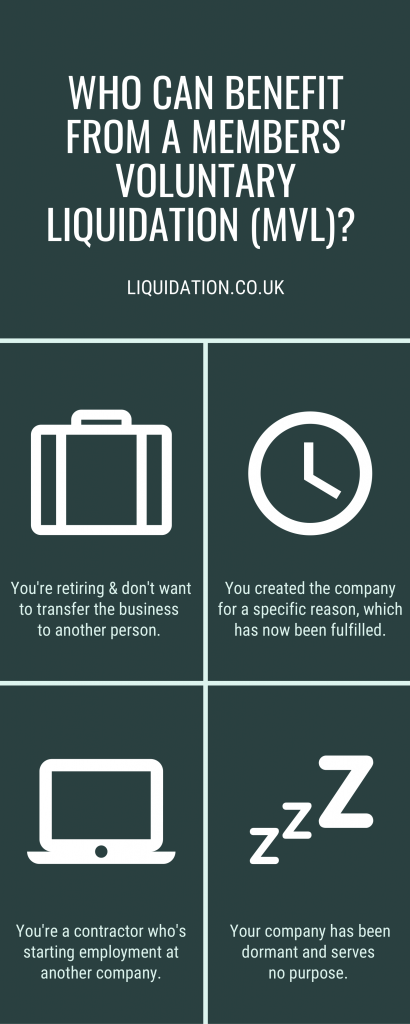The reasons a Members’ Voluntary Liquidation is required
A Members’ Voluntary Liquidation (MVL) is the liquidation of a solvent company. ‘Solvent’ means that your company has no problem paying its debts in full and on time. You most likely also have profits in your company.
If you’re looking to close your business and it’s solvent, an MVL could be the fastest and most profitable way to close your business. These are the reasons a Members’ Voluntary Liquidation is required.
To take advantage of tax benefits.
If you’ve retained profits in your company that total more than £25,000, the reasons a Members’ Voluntary Liquidation is required are to take advantage of Business Asset Disposal Relief (which used to be called Entrepreneur’s Relief) and reduce your Capital Gains Tax.
Here’s how it works:
When you close your company, you’re able to distribute funds below £25,000 as capital. For amounts above that, you have to pay Capital Gains Tax. But…if you liquidate using an MVL you can distribute up to £1,000,000 and pay just 10% in tax.
To save money and time
If your company has been dormant for sometime and you don’t intend on using it again, the reasons a Members’ Voluntary Liquidation is required are to save you money on accountancy fees or remove the hassle of doing your own annual confirmation statement and set of accounts. Plus an MVL will extract any profits from your company so you could be much better off as a result.
To avoid the tax issues of IR35
IR35 refers to the classification of people working for a company as a contractor or employee. It’s especially relevant if you earn most or all of your money by working for one company, or through just one contract. If this is the case, you could technically be classed as an employee of that company. This changes the tax you need to pay. Should you try and avoid paying this tax, matters can get quite serious and end up at a tribunal.
For this reason, many contractors begin with their main client as an employee. In this instance, the reasons a Members’ Voluntary Liquidation is required are to close your company quickly and efficiently, and extract the most amount of profit from it.
To make sure things are done properly
When closing a company, some people choose to strike off their company as an alternative to an MVL. They still close their company, pay out the capital and sell any assets as would happen in an MVL. The difference is that this is done without the aid of a formal procedure or a licensed insolvency practitioner to make sure that all factors are taken into account.
In some cases, debts – like tax bills – are forgotten about, until you receive an angry letter from HMRC. There’s also the possibility that the company’s assets are not sold. If the company is closed and struck off before the sale, the property then becomes the property of the Crown. This is referred to as Bona Vacanita. Avoiding this circumstance is one of the major reasons a Members’ Voluntary Liquidation is required to close your solvent company.
How can liquidation.co.uk help you understand the reasons a Members’ Voluntary Liquidation is required?
Whatever your unique situation, our licensed insolvency practitioners will guide you through the Members’ Voluntary Liquidation process and get the most back from your business. In many cases, we can even pay you the funds from the liquidation before the MVL process takes place.
As industry leading experts with 40 years’ experience, we are in the best position to match any like for like quote ensuring you receive the best service for the lowest price.
The reasons a Members’ Voluntary Liquidation is required

FAQs
Is my company solvent or insolvent?
A company is said to be solvent when it can pay all its taxes, repay all its debts to creditors and can meet all its contractual obligations on time and in full.
If you cannot do one or more of the above then your company may be insolvent. As licensed insolvency practitioners, we’re experts in rescuing businesses from insolvency and bringing them back into profit. Speak to our experts about how we could save your business.
Can I do a Members’ Voluntary Liquidation myself?
A Member Voluntary Liquidation must be completed by a licensed insolvency practitioner. You will not be able to go through the process without one. The added benefit of having an expert on your side is that we are just that…experts. This makes the process smooth and generally hassle-free.
What happens in a Members’ Voluntary Liquidation?
This is a quick overview of the MVL process.
- The company directors make a statutory declaration of the company’s solvency. This needs to include a closing financial statement that’s been signed with a solicitor or notary as witness.
- A meeting of the company’s shareholders takes place so you can get their approval of the liquidation and to appoint a liquidator.
- The liquidator takes charge of your company, closes it and starts the MVL process.
- A notice of your liquidation is sent to The Gazette.
- Your company’s assets are valued and sold. The proceeds are used to settle outstanding debts and to pay shareholders.
- A request for your company to be ‘struck off’ the register is sent to Companies House.
Review
There are no reviews yet. Be the first one to write one.
